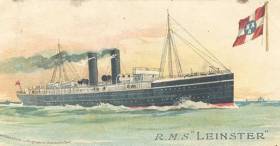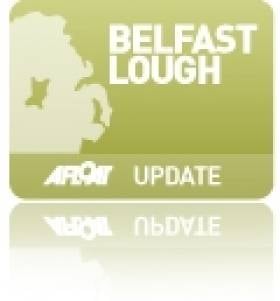Displaying items by tag: WWI
Centenary Lecture: The Sinking of the Leinster
#Lecture - In this centenary year of the great disaster that struck RMS Leinster, the Dun Laoghaire Borough Historical Society is hosting next week an illustrated lecture titled "The Sinking of the Leinster".
Presenter Cormac Lowth will outline the disaster which occurred in the Irish Sea when the mail-boat RMS Leinster having departed Kingstown (Dun Laoghaire) Harbour bound for Holyhead, was torpedoed off the Kish Bank by a German submarine during WW1 on October 10th 1918. The incident on board the City of Dublin Steam Packet vessel led to a horrendous loss of life.
The evening lecture is on Wednesday, September 19th at 8.00. The venue is the Royal Marine Hotel, Dun Laoghaire, where there will be an admission fee of €3.
At the hotel off Marine Road, free car parking in the grounds of the venue is available to those attending the lecture. Check in your ticket at the reception desk.
For further information on other events this month and in October, organised by the The Mail Boat Leinster Centenery Committee visit their website by clicking here.
Belfast Harbour Boat Tours and WWI Warship Gem
#BELFAST HARBOUR TOURS- If there was ever a time to take a tour of Belfast Harbour, it is now on board the Lagan Boat Company, particularly in light of on-going developments as previously reported to keep the WWI veteran cruiser HMS Caroline in the city, writes Jehan Ashmore.
The 98-year old ship which is the last survivor of the famous Battle of Jutland in 1916, is facing another battle from threat of scrapping or a new life albeit towed to Portsmouth's Historic Dockyard for preservation. Yet there is a campaign to keep the historic ship in the city as tourist attraction.
A great opportunity is provided on board the excursion as the very informative guided-boat tour gives unrivalled access to HMS Caroline moored in Alexandra Dock.
While en-route, the excursion boat which departs from Donegall Quay (several minutes-walk from City Hall), passes the new Titanic Belfast visitor attraction and the world famous symbolic Samson and Goliath cranes at Harland & Wolff.
As the boat enters Alexandra Dock, passengers get very much up close and personal views of HMS Caroline, as the riveted hull complete with portholes looms above. As of a result, one immediately senses a different era in shipbuilding techniques with her cruiser stern and highly flared bow. In addition her distinctive profile of three funnels resembling liners also of old and a tripod foremast.
Since she first came to Belfast in 1924, HMS Caroline has performed various roles. She acted as a floating administrative base during WWII. She then became headquarters and training ship for the Royal Naval Volunteer Reserve in Northern Ireland.
Her career came to an end after 97 years with the Royal Navy, when formally decommissioned by the MoD when reserves transferred to HMS Hibernia (not a ship) in Thiepval Barracks in Lisburn during March 2011. For more about the campaign and proposals to save the ship in her homeport, click HERE





























































